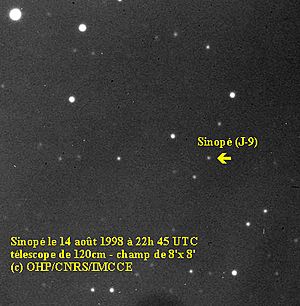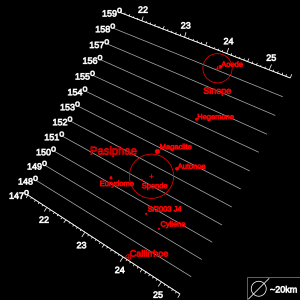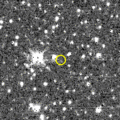Sinope (moon) facts for kids
 |
|
| Discovery | |
|---|---|
| Discovered by | S. B. Nicholson |
| Discovery date | July 21, 1914 |
| Orbital characteristics | |
| Periapsis | 18,237,600 km |
| Apoapsis | 30,191,200 km |
|
Mean orbit radius
|
23,540,000 km |
| Eccentricity | 0.25 |
| 724.1 d (1.95 a) | |
|
Average orbital speed
|
2.252 km/s |
| Inclination | 128.11° (to the ecliptic) 153.12° (to Jupiter's equator) |
| Satellite of | Jupiter |
| Physical characteristics | |
|
Mean radius
|
~19 km |
| ~4500 km2 | |
| Volume | ~28,700 km3 |
| Mass | 7.5×1016 kg |
|
Mean density
|
2.6 g/cm3 (assumed) |
| 0.014 m/s2 (0.001 g) | |
| ~0.023 km/s | |
| Albedo | 0.04 (assumed) |
| Temperature | ~124 K |
Sinope is one of the many moons that orbit the giant planet Jupiter. It is not perfectly round, like a ball.
An astronomer named Seth Barnes Nicholson first found Sinope in 1914. He discovered it while working at Lick Observatory. The moon is named after a character called Sinope from Greek mythology.
For many years, Sinope was simply known as Jupiter IX. It didn't get its official name until 1975. Between 1955 and 1975, some people even called it "Hades".
Sinope used to be the farthest known moon from Jupiter. But then, in 2000, another moon called Megaclite was discovered. Today, the very farthest moon of Jupiter that we know of is S/2003 J 2.
Sinope's Journey Around Jupiter
Sinope travels around Jupiter in a special path called an orbit. This orbit is quite unusual because it is very stretched out (high eccentricity) and tilted (high inclination). It also moves in the opposite direction to Jupiter's spin, which is called a retrograde orbit.
The way Sinope orbits changes a lot. This is because the Sun and other planets pull on it with their gravity. Scientists often think Sinope belongs to a group of moons called the Pasiphaë group. However, Sinope's orbit and its color are different from the other moons in this group. This makes some scientists think Sinope might have been captured by Jupiter on its own. It might not be from the same event that created the rest of the Pasiphaë group.
What Sinope Is Like
Sinope is a small moon. Scientists estimate it is about 38 kilometers (about 24 miles) wide. This is based on how much light it reflects.
Interestingly, Sinope looks red. This is different from Pasiphaë, which is a grey moon. When scientists study Sinope's light using infrared tools, they find it looks similar to a type of asteroid called a D-type asteroid. These differences in color and light suggest that Sinope might have a different origin story than the other moons in its group.
Images for kids
See also
 In Spanish: Sinope (satélite) para niños
In Spanish: Sinope (satélite) para niños



